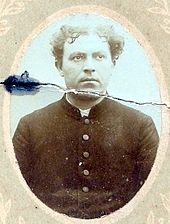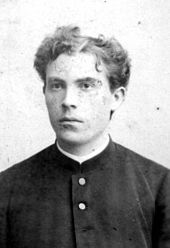Martin Hemmer (priest)
Martin Hemmer (born February 6, 1863 in Niederlustadt , Palatinate ; † July 28, 1947 in Hainfeld , Palatinate) was a Catholic priest from the Diocese of Speyer , later archpriest and commissioner in the Archdiocese of Breslau , and co-founder of the agricultural cooperative system in Silesia and papal house prelate (Monsignor). Due to the consequences of the Second World War, he was a victim of displacement ; his grave in Hainfeld is a regular meeting point for those expellees from his long-term place of activity Schmottseiffen / Silesia and an official connection between the group of expellees and the Palatinate community developed from this.
Life
Origin and early work
Martin inhibitor is in the southern Palatinate Niederlustadt, Rheinpfalz, then Kingdom of Bavaria born, the Episcopal attended boarding school (boarding) St. Joseph in Speyer and received on 19 August 1888 by Bishop Joseph Georg von Ehrler in Speyer Cathedral , the ordination . At first he officiated as chaplain of his home diocese in Homburg , where he especially took care of the miners.
Priest and prelate in Silesia

Since there was a great abundance of clergy in the diocese of Speyer at that time, Hemmer accepted an offer from the Reichstag deputy Count Friedrich von Praschma , who was looking for a tutor and chaplain in Silesia . In this position he worked at Falkenberg Castle from 1891 to 1896 . On August 31, 1891, he received permission to transfer from the Diocese of Speyer to the Diocese of Breslau. Here Hemmer officiated from 1896 to 1898 as curate in the city of Breslau to St. Heinrich and St. Matthias. At the same time he taught at the "König Wilhelm Gymnasium" and held the office of president of the metropolis' catholic master craftsman association. Then he moved to Seitsch , Guhrau district , as pastor , where he stayed from 1898 to 1907. In that year he took up his last pastorate in Schmottseiffen, now a district of Lubomierz as Pławna Górna . There he held office for 39 years, until he was expelled in 1947. In 1919 he was appointed archpriest and archbishop commissioner of the Hirschberg district (similar to a dean). On the occasion of his golden jubilee of consecration, Martin Hemmer was promoted to the papal house prelate with the title "Monsignore" due to his various services in the priestly office . He was heavily involved in the agricultural cooperative system and was one of its initiators and co-founders in the province of Silesia . In addition, he was considered a "recognized specialist in the field of music and art". Both hold the honor of his golden jubilee as a priest, where he is also described as "open to all problems of the present day and always familiar with the new publications of theological specialist literature". His archbishop, Cardinal Adolf Bertram, had particularly valued him because of his tireless zeal and he was in personal, friendly contact with him. Hemmer also worked as a synodal consultor in the diocese and was a member of the board of trustees that administered the priestly pension fund. The historically interested clergyman had been a member of the "Association for the History of Silesia" since 1899 and is mentioned or cited several times in its organ "Journal of the Association for the History of Silesia"; u. a. in Volume 46, 1912, p. 254, where there is also a reference to his treatise, "The establishment of the chaplaincy in Schmottseiffen, 1748" , published in the Schlesisches Pastoralblatt , Volume XXXII, No. 19 . Pastor Martin Hemmer is registered as a member and participant in the official report on the 56th German Catholic Convention (Deutscher Katholikentag) in Breslau, from August 29 to September 2, 1909 (Festschrift page 654).
Displacement Victims and Death
After the Second World War , the aged prelate Hemmer, like many others, was expelled. Father Alfred Rothe SJ reported in his "History of the village of Schmottseiffen" that Pastor Hemmer and his chaplain Maniera belonged to the last large group of refugees who left the congregation in June 1947. Both priests had all their possessions taken away when they crossed the border. The publication also contains two letters from Pastor Hemmer in which he himself reports on his expulsion and the circumstances surrounding it. The Palatinate priest writes z. B. on February 27, 1946 from Schmottseiffen to the monastery provost in Lauban :
“ ... After I had spent evacuated in Bad Flinsberg from March 23, 1945 to June 3, 1945 , I returned to Schmottseiffen after the armistice. Saturday, June 23, 1945, at midnight, we were pushed out of our apartments with rifle butts and robbed. I have not yet received any signs of life from my relatives. Wherever the British and the Americans are in occupation, all economic life is said to be going again. The Catholic Sunday paper appears regularly in Berlin. It seems like a fairytale to us that something like this is possible again. From December 1st to 3rd, 1945, 16 Poles looted me. While I was sick in bed, my bedroom was cleaned out myself. They left three big wagons of booty; including valuable chalices and ciborias. The crypt under our church was also broken into and searched. God commands and greetings from the whole rectory! Martin Hemmer, prelate, at the age of 84. "
In view of his imminent deportation, he sent the parishioner Heinrich Brendel, now in the west, a postcard with premonitions:
“ Schmottseiffen, November 26, 1946. Dear Heinrich. Your letter of October 31, 1946 received here on November 22nd. Gratias! Now I have an insight into your life abroad! In the old German language foreign means as much as misery. Where there is a Christian spirit, misery is alleviated by brotherly mercy, but home is not replaced! Now we are all called by God and are forced to leave everything and take up the vagabond life as a profession! Until now it has been said here that the prelate will remain in his 84th year; but now the slogan is: "All German clergy and teachers must go!" Since I can no longer stand the transport of several weeks in winter in my old age, I no longer need to work as a vagabond and beggar for much longer. On the way, death will free me from this misery! So that my niece Miss Meta Hemmer, Hainfeld / Rheinpfalz, Zone Francaise no longer needs to take me in. God commanded goodbye in heaven. "
Pastor Martin Hemmer came to his niece in Hainfeld, Palatinate , sick and broken, after a five-week journey in a freight car in the summer of 1947, and died there after a short time. He is a direct victim of the forced eviction and was buried in the Hainfeld cemetery. The diocese newspaper of his home diocese of Speyer, " The Pilger ", brought the diocesan who had returned home under tragic circumstances a lengthy obituary and also published an obituary. In the necrology it is said, among other things, that the clergyman never let go of contact with the Palatinate in Silesia. Until the pilgrimage was banned in 1941, he received the newspaper as a subscriber to Schmottseiffen and was informed about the deaths in the local clergy in order to be able to commemorate them at the Holy Mass.
The displaced people from Schmottseiffen, who are scattered in what is now Germany, have been meeting regularly for decades in Hainfeld, Diocese of Speyer. The grave of her last local pastor, Prelate Martin Hemmer, has become a place of identification for her with her old home community or a place of remembrance and pilgrimage. (Message from Pastor Paul Brendel, October 8, 2009).
The circle of friends of former Schmottseiffeners also took part in the 1225th anniversary of Hainfeld in 2006, and through its regular meetings at the grave of Prelate Hemmer, they have a variety of friendly relations with the South Palatinate community. The chairman of the Silesian Circle of Friends congratulated the village at the official ceremony, about which the press, among others, the largest regional daily newspaper Rheinpfalz reported on July 3, 2006: "... Oswald Rößler from the Circle of Friends of former Schmottseiffener, who maintain a close bond with Hainfeld because her last clergyman Martin Hemmer is buried in Hainfeld, sent warm greetings. "
literature
- The pilgrim : Palatine celebrates the golden jubilee of priests in Silesia. In: Pilgrims. No. 34, dated August 21, 1938.
- The Pilgrim: Obituary Prelate Martin Hemmer. In: Pilgrims. No. 33/34, of August 17, 1947, obituary notice in the next issue.
- Alfred Rothe: History of the village Schmottseiffen. Self-published.
- Paul Brendel: Festschrift 750 years of Schmottseiffen. 1991.
- Archive for Silesian Church History, Institute for East German Church and Cultural History. 1992, Volume 49, p. 288 (Appreciation of Prelate Hemmer and his grave, which is referred to there as the “post-expulsion bracket” .)
- Franz Scholz, Helmhart Kanus-Credé: On the suffering and death of Silesian priests 1945/46, an excerpt from the Silesian Passion. Antigone-Verlag, 2002, ISBN 3-929987-71-6 , p. 96.
Web links
- Website about the village of Seitsch, with the name and photo of Pastor Hemmer
- Current website of the parish of St. Heinrich in Breslau (Polish), with the name of Pastor Hemmer as pastor there for the years 1896–1898 ( Memento from December 28, 2011 in the Internet Archive )
- Festschrift 750 years of Schmottseiffen, Paul Brendel, 1991, with details on Pastor Hemmer and the expulsion.
- Two letters from Pastor Martin Hemmer in the original text
Individual evidence
- ↑ Schematism of the Diocese of Speyer, 1893 edition, p. 164.
- ↑ Website on the parish of St. Heinrich Breslau, with a mention of Pastor Hemmer in the 2nd section of the text ( Memento from January 21, 2010 in the Internet Archive )
- ↑ Website on the history of Schmottseiffen with a photo of the village and church
- ^ Paul Hemmer, History of the village of Schmottseiffen ( MS Word ; 203 kB)
- ^ Rheinpfalz reports on the local anniversary Hainfeld, mention of Pastor Hemmer and Schmottseiffen in the 2nd report
| personal data | |
|---|---|
| SURNAME | Hemmer, Martin |
| BRIEF DESCRIPTION | Catholic priest, papal house prelate, victim of displacement |
| DATE OF BIRTH | February 6, 1863 |
| PLACE OF BIRTH | Niederlustadt |
| DATE OF DEATH | July 28, 1947 |
| Place of death | Hainfeld |


